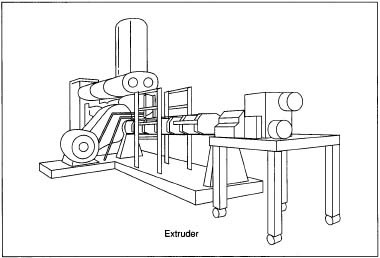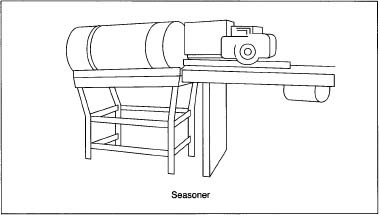Cheese Curl
Background
Cheese curls, sometimes referred to as corn curls or cheese puffs, have been a popular American snack food since the 1950s. These crispy cheese snacks are formed from cornmeal, water, oil, and flavored coatings. Cheese curls are an extruded snack, meaning they are cooked, pressurized, and pushed out of a die that forms the particular snack shape. They are then baked (or fried, depending on the product) and flavored with oil and seasonings. Today, we eat extruded corn snacks that are ball-shaped, curly, straight, or irregularly shaped depending on the shape of the die. Flavorings added after baking or frying vary greatly and different brands have distinctive flavors. These snacks are extremely popular snacks with children. The cheese curl industry packages them so that they are an easy choice to drop into school lunches.
History
The invention of the cheese curl was quite serendipitous. During the 1930s, the Flakall Company that produced corn-based feed for livestock sought a way to produce feed that did not contain sharp hulls and grain dust and eventually produced a machine that broke the grain into small pieces by flaking it. The Flakall Company became successful manufacturers of flaked feed. One day as Edward Wilson was working as a flake operator at the Flakall Company, he noticed that workers poured moistened corn kernels into the machine to reduce clogging. He found that when the flaking machine ran continuously it made parts of it quite hot. The moistened cornmeal came out of the machine in puffy ribbons, hardened as it hit the air, and fell to the ground. Wilson took the ribbons home, added oil and flavor and made the first cheese curls. The company ran another flaker just for the production of Korn Kurls. By 1950, the Adams Corporation was mass-producing the Korn Kurl. There were dozens of small snack companies that followed the Adams Corporation and produced cheese curls, with many devising their special shape using innovative dies for their extruded snacks. Today, perhaps the most popular cheese snacks are produced by Frito-Lay although they did not offer any such snacks until 1980. This company offers the product in a variety of shapes and flavorings (including one that is flavored with cayenne pepper). Despite their minimal nutritional value (they are high in calories and fat and offer little fiber or protein), they are quite popular. It is estimated that 82% of Americans with families have eaten cheese curls at some point.
Raw Materials
The cheese extrusion itself is generally made from two primary ingredients: cornmeal and water. All other ingredients are sprayed or applied to the corn curl after it leaves the extruder and is dried. The coatings vary greatly according to flavor and the manufacturer. Soybean and/or cottonseed and/or coconut oil may be sprayed on the extrusions. Then, powders such as cheddar cheese powders, acid whey powder, artificial cheese flavor, salt, and other spices are often applied over the oil.
The Manufacturing
Process
This section will focus on the production of baked cheese curls. The process for making

Mixing
- 1 Cornmeal is carefully chosen for use in puffed corn curls. The cornmeal must be of fine texture so that it produces a pleasant feel as it is eaten. Also, cornmeal with a low moisture content of 6-10% is used in this process. Too much moisture in the meal will render the product soggy. Cornmeal inspected for moisture content is placed into a mixing bin and sprayed with a fine mist of water as it is stirred. Water poured directly into the meal will result in gluten formation, uneven distribution of moisture, and clumping of wet grain. When the desired consistency is achieved, the mixture is immediately extruded. Holding the mixture too long often results in additional water absorption and the mixture cannot be used. If the cornmeal slurry cannot be used immediately, it must be stored in an airtight container.
Extruding the collettes
-
2 The cornmeal mixture is loaded into the top of the extruding machine.
The batch becomes rather gelatinous as it is exposed to heat, moisture,
and pressure. The mixture is then propelled through the extruder using
an auger or tapered screw. This screw forces the mixture against the
inside of the extrusion chamber, creating a shearing effect when
pressure is increased. Steam jackets line the extrusion chamber to
assist in cooking the meal mixture. When the cornmeal reaches the die it
should be hot, elastic, and viscous. The moisture is liquid under high
pressure but changes to steam as it reaches lower pressure on the other
side of the extrusion process. The result is that the cornmeal dough
expands and puffs up as it moves through the extrusion dies.
The shape of the die is a critical aspect of its product because it gives the product its distinctive shape. As the dough is pushed through the dies, it looks like puffy snakes. These extruded snakes called collettes are cut to the desired length by a rotating knife.
Drying the collettes
-
3 The collettes still contain between 6-10% water at this point
(depending on the recipe and the manufacturer) and must be dried out.
So, the collettes are conveyored
to a large oven called a dryer. They move continuously through the dryer until they emerge at the other end crisped up considerably. The dryer generally is about 140° F (59.9° C)—hot enough to get the moisture out but not to darken the collette. The collettes require about five minutes to dry out and are reduced to between 1-2% moisture.
 The extruded cheese curls can be seasoned using a flavor reel. In this process, the oils, flavors, spices, and color are mixed together in a tank and sprayed on the curls as they are tumbled in a barrel. Once flavored, the curls are dried and packaged.
The extruded cheese curls can be seasoned using a flavor reel. In this process, the oils, flavors, spices, and color are mixed together in a tank and sprayed on the curls as they are tumbled in a barrel. Once flavored, the curls are dried and packaged.
Separating the fines
- 4 The fines or small particles that are produced as the collettes are conveyed to the dryers must be separated from the nicely-formed collettes. (The fines tend to absorb oil and flavorings and are undesirable to include in a package of cheese curls. Some modern dryers are self-cleaning and automatically deposit the fines in a cross conveyor for removal from the machine.
Flavoring the collettes
- 5 As the collettes move through the oven, they are sent to the flavor coating station. They are still bland cornmeal crisps and must receive a coating in order to be palatable. They may be coated using one of two methods. In the first method, the extruded corn curls are first sprayed with vegetable oil and then dusted with a variety of dry flavors, seasonings, and color. In the second method, the oils, flavors, spices, and color may be mixed together in a tank and sprayed on the collettes as they are tumbled in what is called a flavor reel. In either process, it is essential that oil is placed on the surface of the collette in order for the flavors and spices to stick to the snack. The flavored snacks now sit on a conveyor and dry before they are packaged.
Packaging the cheese curls
- 6 The cheese curls move along the conveyor belt and are dried. A vibrating conveyor belt moves the snacks along until they fall into the weigher. The weighing machine weighs out just the right amount of curls to go into a bag and puts them into a chute. (Cheese curl bags may be made of polypropylene which are resistant to moisture and keep the product crisp.) Huge rolls of flattened bags are loaded into the weighing machine, formed, and prepared to receive the corn curls that drop into the bags. The bags are then heat sealed. Cartons of bags are packed and shipped to a warehouse.
Quality Control
One of the most important quality control steps in the entire process is selecting cornmeal for use. First, it must be finely ground because big grains or gritty meal result in an undesirable feel as the finished product is consumed. Cornmeal is tested for grit size by weighing 1.75 oz (50 g) of a well-mixed, representative sample of meal. Then, the test sample is transferred to the top sieve of a series of different grades of sieves. The grain is poured on top and agitated as it is put through the sieves. The grain remaining on the sieves is considered too coarse to use; this amount is weighed and the approximate usable grain is calculated and compared to specifications sent from the supplier. Next, moisture content of the grain is assessed because too-wet or too-dry cornmeal will create inferior product. (Excessive moisture will cause formation of small, heavy, hard puffs, while too-dry cornmeal will create light, long, straight puffs. Puffs that are too dry will burn in the dryer.) Moisture content is determined by weighing a 0.07-0.105 oz (2-3 g) portion of cornmeal, placing it a uncovered in the self of an oven for exactly 60 seconds, then re-weighing the samples and calculating the amount of moisture loss. The meal must not lose more than 0.2% of weight (moisture) of the cornmeal may be considered too wet for use at that point.
The equipment used in the manufacture of the extruded snacks is calibrated and checked very carefully throughout the production process. Industry and food technology manuals indicate the proper rate of feed into and through the extruder, the number of revolutions per minute at which the extruder must run, the temperature of the extruder, the pressure (measured in Atmospheres) that must be maintained in the extruder, the speed of the extruder, and the rotating speed of the knife that cuts the collettes. Human operators constantly check the extruding dies to ensure they have not plugged up. Extremely important is determining the amount of water that must be added to the cornmeal in order for it to become gelatinous. The moisture content of the product as it enters the extruder, as well as when it exits (just before the baking that crisps it up), is carefully assessed. Machinery is programmed so that the duration of the processes described above are perfectly timed in order to ensure each step is thoroughly completed.
The Future
The puffed corn snack is a recently developed manufactured product. As such, it has seen many interesting variations and improvements in the past two decades in particular. Companies are constantly seeking new flavors to spray onto the extruded cornmeal collettes. Recently, very spicy coatings have been added to one company's product and they are selling well. One company that sells extruding machines and dies advertises that they look forward to working with food manufacturers in order to develop new, unique product. Furthermore, it is possible to extrude other grains in the extruder and perhaps the snack food industry will see how well wheat or rye puffs may sell in the near future.
Where to Learn More
Books
Herbst, Sharon Tyler. "Cornmeal," In The Food Lover's Second Edition. Barron's Educational Services, Inc.
Snack Food Association. Corn Quality Assurance Manual. Alexandria, VA: Snack Food Association, 1992.
Snack Food Association. Corn Quality Assurance Manual. Alexandria, VA: Snack Food Association, 1994.
Other
Frito-Lay. 1998. http://www.fritolay.com/ (June 7, 1999).
Snack Food Association. http://www.snax.com/ (June 7, 1999).
Wenger Extrusion Systems. 1999. http://www.wenger.com/ (June 7, 1999).
— Nancy EV Bryk